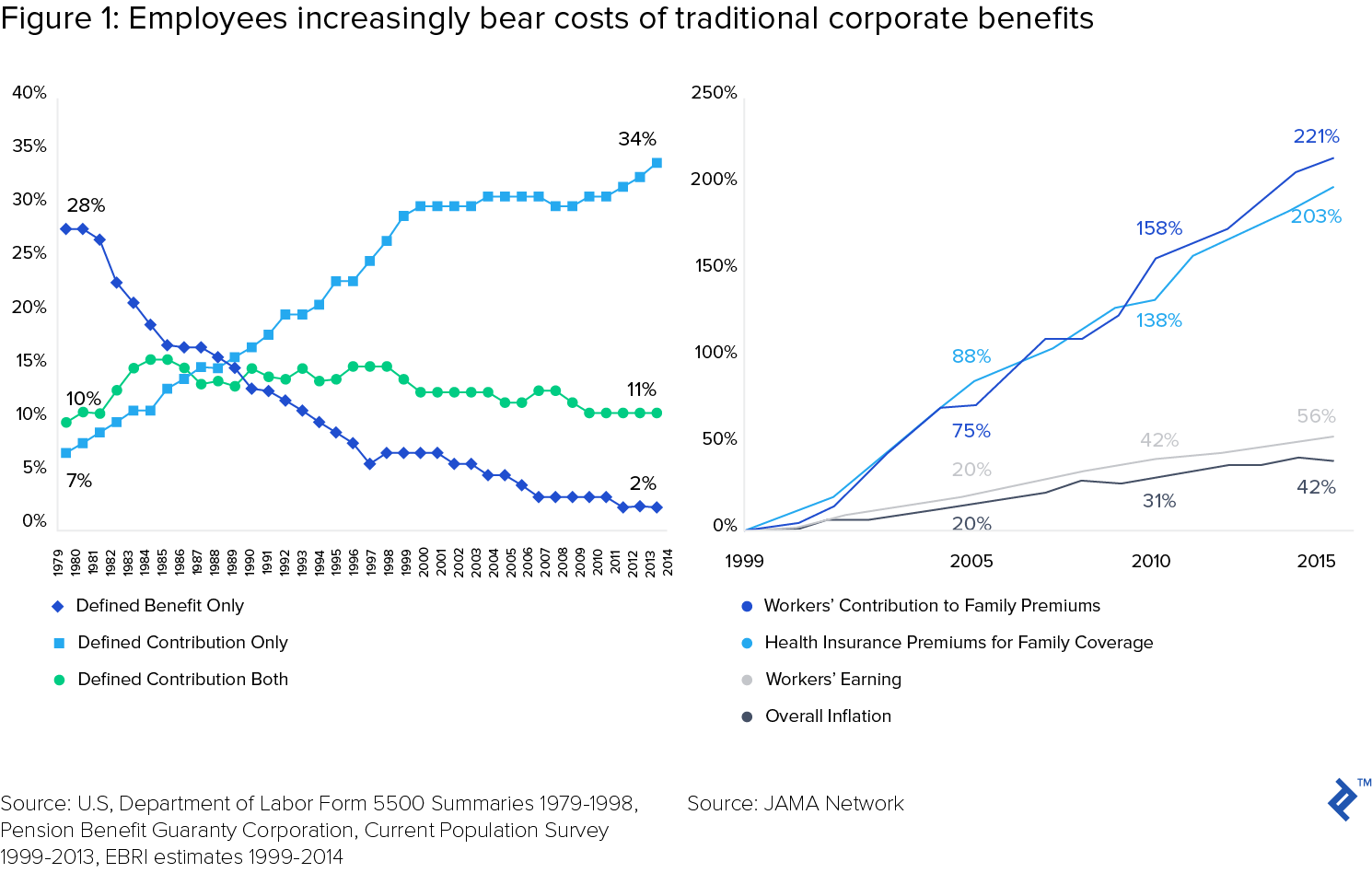Don't Fight Employee Turnover. Accept, Adapt, and Leverage It.
Although employee tenures are decreasing, innovative companies embrace the trend as an opportunity to maximize impact. In this article, Andy Anderson, a Toptal Client Partner, shares perspective on how such companies view - and capitalize on - employee attrition.
Although employee tenures are decreasing, innovative companies embrace the trend as an opportunity to maximize impact. In this article, Andy Anderson, a Toptal Client Partner, shares perspective on how such companies view - and capitalize on - employee attrition.

Andy Anderson
As a Client Partner, Andy helps clients build teams around their most pressing challenges by tapping into the power of the human cloud.
It used to be that a career would play out at a single firm. While titles changed and responsibilities grew, employees accrued impressive tenure, measuring service to their company in decades. The pinnacle of professional achievement was the corner office situated neatly at the top of a clearly defined corporate ladder. Today, careers play out across functions, jobs and even industries, often requiring workers to switch companies in order to advance. As a result, increasing employee turnover has become an inevitable byproduct of the modern career path.
Increasing employee turnover has become an inevitable byproduct of the modern career path.
A growing body of research documents the various macroeconomic, generational, and technological drivers of the changing career landscape. At the forefront is always the discussion of Millenials and more recently Generation Z. Younger workers, while no less motivated by professional development, now prioritize a different set of goals, including schedule flexibility, leadership training and targeting work that they find meaningful. To reach these objectives, workers are charting non-linear career paths which, in turn, require companies to adapt expectations.
Attracting, acquiring, and engaging the best talent is critical to maintaining competitive advantage. It can also be very expensive. HR and business leaders alike have a visceral drive to hold onto great people when they find them. For this reason, retention has long been counted among the most critical KPIs of a firm’s health. However, for the reasons discussed above and many more, long-term employee retention increasingly seems an impossible task.
As highlighted in a recent LinkedIn Global Recruiting Trends report, employee turnover is highest in top-priority roles such as sales, engineering and operations. Such high-value employees are sought after and often compelled to leave. Traditionally, the notion of losing such employees - particularly to a competitor - could only be considered a loss. Such loss aversion is justified; new employee acquisition and onboarding are expensive. As a result, most companies view the departure of employees with chagrin, but they should embrace such behavior as an opportunity.
Traditional corporate career paths defined employee tenure
It used to be that a career played out in a single building. As an employee proved herself, she gradually moved to a better cube, gained more responsibilities and earned a bigger paycheck. The path was clear and often linear. The pinnacle was the corner office, perhaps one amongst the executive suite.
Practical considerations supported this career path. Companies themselves made longer-term commitments to employees, often providing job security, substantial health benefits and pensions. For a young professional, committing an entire career to a single company made sense.
However, corporate context has changed and so has the proposition for such employees. In an era of mergers and acquisitions, private equity ownership and seemingly pervasive downsizings, no job is permanently secure. Further, many corporate benefits have been eliminated or significantly reduced. For example, employee participation in defined benefit plans such as pensions has been steadily declining over the past 25 years, replaced by the rise of defined contribution plans such as the 401(k). In a similar trend, employees increasingly supplement their healthcare costs.

A snapshot of the evolving corporate environment
While the relationship between employer and employee has surely changed, tectonic shifts are also affecting the fundamental nature of work. Bersin by Deloitte identifies seven key disruptors driving unprecedented change and opportunity in the future of work. Looming large among these factors are the changing nature of a career and the explosion in contingent work. Companies that fail to develop strategies that specifically address these disruptors risk stymying innovation and limiting their access to critically needed skills.
The average tenure of an employee below the age of 36 is 3.2 years. Numerous conversations with hiring managers corroborate this statistic, particularly in technology-focused roles where managers recognize that employees are hyper-aware of the need to continuously acquire new skills. Bersin notes that today, the half-life of skills is between 2.5 and 5 years. When an employee begins to feel she is no longer acquiring skills in her current role, she’s likely to begin looking for the next gig.

Job hopping historically weakened resumes by calling to question worker loyalty, but now such behavior seems to accelerate career advancement. Once guided by career counselors, recruiters and prevailing sentiment, professionals have historically been encouraged to establish a track record of promotions within a single company. With rare exception, such advancement requires, at minimum, a three to five year commitment to a single employer.
In response to this reality, employees often seek greater learning opportunities, faster promotion and pay growth by switching companies more frequently. Pursuing such opportunity, as the WSJ reports, nearly one in seven of the nation’s 6.1 million jobless Americans is voluntarily unemployed, having left a previous position to look for another. A rich job market has driven such unemployment to nearly 20 year highs.

The most innovative companies embrace shorter employee tenures, often deriving outsized impact from what might otherwise be considered less valuable workers. For example, as prior Netflix Chief Talent Officer shared in a FastCompany article, employees “build skills faster when changing companies because of the learning curve.” Her advice to companies: “view employees as smart contributors from the beginning.”
Paradoxically, scarce time may drive abundant results.
In other words, if both new hires and companies acknowledge that the clock is ticking day one, perhaps both will treat the ensuing two years with greater urgency. Paradoxically, scarce time may drive abundant results.
Leading companies are adapting to shorter employee tenure
The Human Capital Institute (HCI) puts it bluntly: “Retention is an overrated strategy that jeopardizes a company’s success, longevity and competitive advantage in the workforce.” Instead of endeavoring solely to hold on to employees, companies should focus on fostering strategies and a culture that embraces a blended workforce. The blended workforce engages traditional employees, flexible and seasonal workers, contractors, and freelancers.
Cultivating a blended workforce positions companies to access the critical skills they require to pursue their missions. Such a culture also serves as an engine of innovation.
PwC finds that 76% of CEOs are concerned about the availability of critically needed digital skills in their workforces and only 26% find that it is easy to attract such talent. The same survey finds that the vast majority of firms are responding to these challenges by implementing strategies that will allow them to access more of the new talent economy. Notably, four out of five are partnering with external providers and nearly the same proportion are embracing mobile and remote work.
In closing, consider the somewhat bold notion that long-tenured employees are often the least likely source of innovative thinking. Underscoring this point, Harvard Business Review (HBR) research on “analogous fields” found that the further a worker is from the context of a target problem, the more novel the solutions they envisioned.
Illustrating this assertion, researchers noted the example of enlisting roofers and skaters to examine the problem of carpenter’s reluctance to wear safety gear. Skaters envisioned solutions much more novel than those adopted by carpenters. In corporate settings, executives and hiring managers should consider - even seek out - the potential “skaters” and harness the power of potentially shorter tenures as a competitive advantage.
